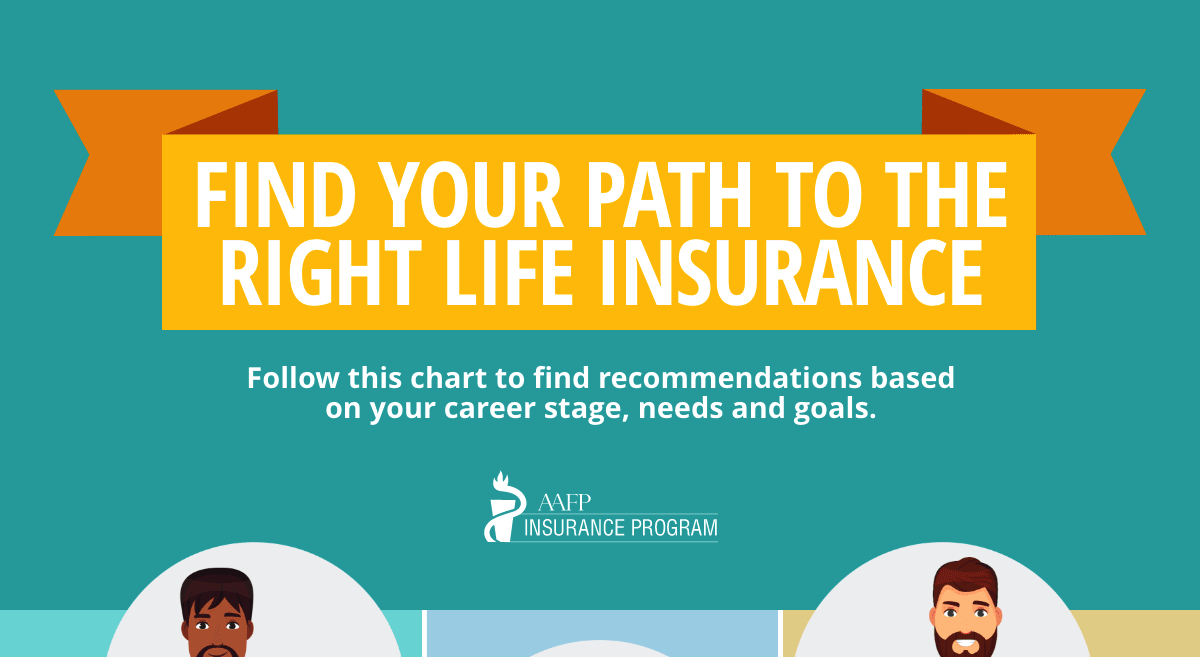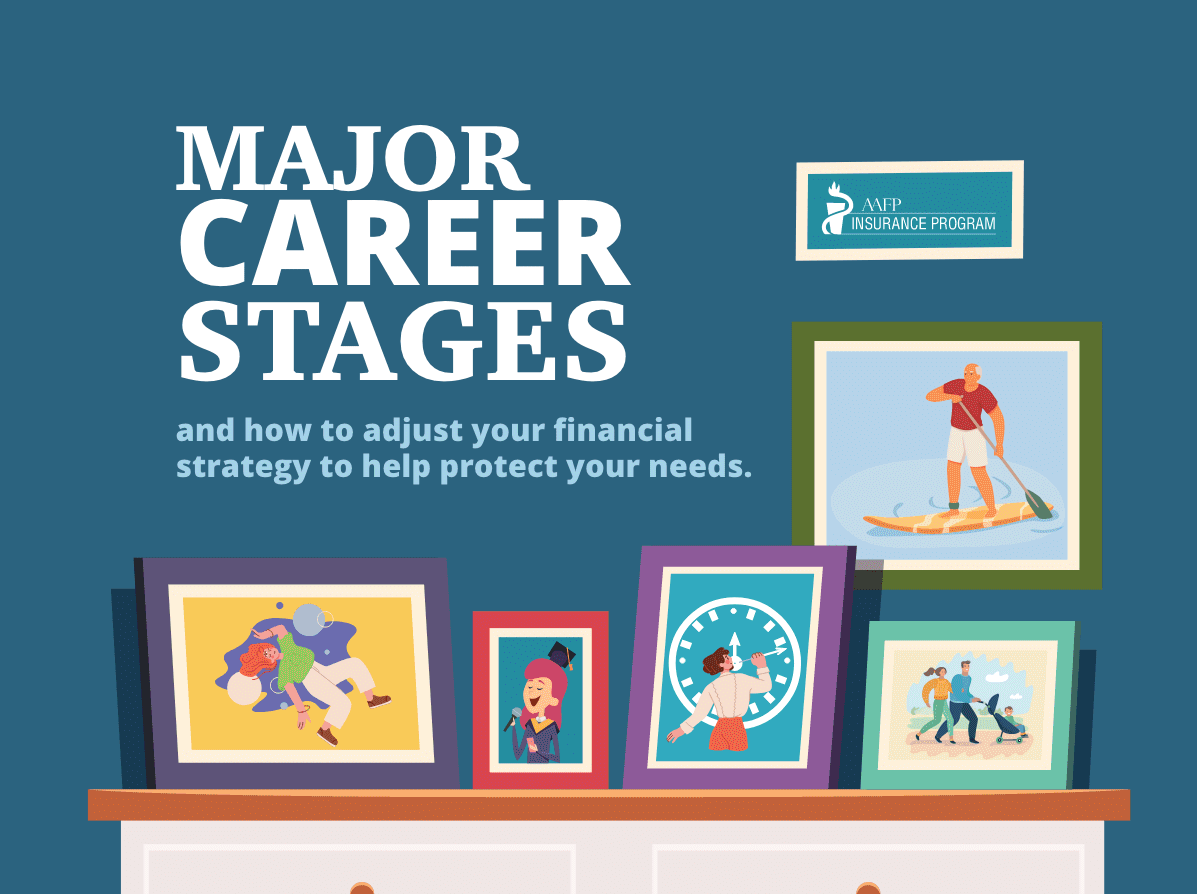Your 20s and 30’s.
A long career ahead.
The rule of thumb is that you should set aside 2% of your income for insurance. But as a family physician, your need may be even greater – especially if you have outstanding student loans, are just starting out or starting a family.
The upside of buying life insurance at this age is that you are young and healthy. And since many insurance premiums are based on your age and health, there’s a good chance you can find protection that fits your budget.
Here are our key recommendations. Prioritize what’s important to you.
Disability Income Insurance – your income is your lifeline, it pays for your living expenses and financial obligations. You need to protect it against an unfortunate accident or illness, or anything that can prevent you from working.
Life Insurance – If you have a family, it’s important to provide those you love with financial protection should something happen to you. Consider a term life insurance policy that covers at least 7 to 10 times your income.
Decide how much coverage you need. Figure out how long you’ll need it. That could be long enough to cover your mortgage … or see your children through school. Then, get a rate quote from a company you can trust. You may be surprised at how affordable term life insurance can be.
For example, a healthy 30-year old man can buy a $500,000, 20-year term policy for just $305 a year. Women pay less for the same coverage: $210 a year. Calculate your premiums to see the rate you’d pay.
Keep in mind, what you do in your 30’s will set the foundation for your family’s financial future, plus create good financial habits that will serve you well as you get older. On that note, we recommend 5 Ways Family Physicians Can Improve Their Financial Security, as a way to build a stronger net worth.
Your 40’s.
Now is the time to prepare for the future.
The good news is that you are a successful, established doctor with 20 years of work behind you. The bad news is that you still have (at least) 20 more years of work ahead of you. This is the time to prepare for the second half of your career and for retirement.
Boost your Life Insurance coverage – If your responsibilities have grown, it’s important to adjust your coverage accordingly. Some options include buying extra insurance for a longer term, converting a term life policy to a permanent life one, or buying a new permanent policy.
At this point in your life you could be thinking about changing jobs or opening your own practice. If this is the case, keep in mind that you may lose your employer-sponsored benefits as a result. It’s important you replace them, so your family’s financial security isn’t at risk.
Disability insurance – If you have not already done so, now is the time to purchase a policy. Protecting everything you’ve worked so hard to achieve — and all the things you and your family have enjoyed at your income level — is important at this stage of your life.
Your 50’s.
Your peak earning years.
With retirement on the horizon, you may want to start consolidating your coverage and making sure everything is in place for you to enjoy life once you stop working. Your children may be grown and on their own, but you may be faced with a new set of responsibilities with grandchildren or aging parents. The right insurance can help.
If you don’t have Life and Disability Insurance yet, or your coverage hasn’t kept up with the changes in your life, now is the time to apply for protection. Mortgages and other outstanding debts could still be an added burden to your family’s financial security.
While in your 50’s, insurance is still affordable, and most importantly, it still makes sense. For example, a 50-year-old male can buy a 10-year term Life Insurance policy, with $500,000 in benefits for $570 a year. A female the same age pays just $480 a year. Calculate your premiums to see how affordable coverage can be at your age.
Long Term-Care Insurance – Although 70% of us can expect to need long-term care as we grow older, long-term care insurance is one of the most overlooked types of protection.
This valuable protection is designed to help cover care in a nursing home, assisted-living facility, even in your own home. You need it because the cost of care is expensive, and it’s not covered by Medicare and other forms of health insurance.
If you are not thinking about it, you are not alone. It’s hard to imagine you’ll need somebody to take care of you, or you may think that your kids will step in. However, we are living longer, healthier lives and an unexpected long-term care event may cause you to burn through your retirement savings 2 to 3 times faster than expected.
The rates you pay for long-term care insurance depend largely on your age and health. The younger you are when you apply, the more likely you are to quality … and the less you’ll pay.
Your 60s.
Your golden years.
It is entirely up to you to design the quality of life you want after you slow down or stop working. To do that, you will need a secure financial plan.
Your priorities may have shifted at this point. Maybe fewer people depend on you financially and your mortgage and debts have been repaid. But that doesn’t mean you no longer need protection.
Life Insurance – You may not need as much as you did when you were younger, but it’s important to carry enough coverage to replace lost income sources for your spouse. The cost of coverage rises with age, but this protection can be an important source of tax-free income, to help pay state taxes, mortgages or fund college tuition.
Disability Insurance – Consider what would happen if you couldn’t work. Would your nest egg and spouse’s income be enough to live on until any retirement benefit starts? If not, you still need insurance.
Final words
Whatever protection you want, it’s advisable that you consider it while you are still practicing family medicine. Since 1951, AAFP Insurance Services has been providing AAFP Members with financial solutions that help our members create, preserve and improve their financial health at every stage of their career.
Proper planning and management from an early stage can make a difference in your career and your life. So tell us, what’s your career stage, and what’s your top priority?




